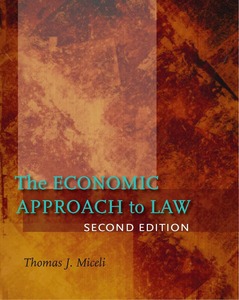Chapter 2
Forms of comparative negligence
The eggshell skull rule
Forms of comparative negligence
There are three basic forms of comparative negligence: pure, modified, and slight-gross. Under pure comparative negligence, which is the version described in the text, a negligent injurer’s liability is reduced in proportion to the contributory negligence of the victim. However, the injurer can avoid all liability by meeting the due standard, x*, regardless of the victim’s care. Formally, the injurer’s liability under pure comparative negligence is determined as follows:
D, if x < x* and y ≥ y* ;
sD, if x < x* and y < y* ;
0, if x ≥ x*;
where s, the injurer’s share of damages (equal to his share of relative fault), is an increasing function of y and a decreasing function of x. Note that if s º 1, this rule is identical to simple negligence, whereas if s=0, it is identical to negligence with contributory negligence.
Under modified comparative negligence, the injurer’s liability is also reduced in proportion to the injurer’s fault, but only if the victim’s fault is less than that of the injurer. However, if the victim’s fault is greater, she is completely barred from recovery. Thus, modified comparative negligence is equivalent to pure comparative negligence if s=.5 and negligence with contributory negligence if s < .5.
Finally, under the slight-gross rule, the injurer’s liability is reduced in proportion to the injurer’s fault only if the victim’s fault is slight and the injurer’s fault is gross. Otherwise, the victim’s fault bars recovery. The rule is thus equivalent to pure comparative negligence for s larger than some threshold above .5 (reflecting gross negligence by the injurer and slight negligence by the victim, or s > 1–s) and negligence with contributory negligence for s less than this threshold.
See W. Page Keeton, Dan Dobbs, Robert Keeton, and David Owen (1984) Prosser and Keeton on Torts, 5th Edition, West Publishing Co., pp. 471-474.
The eggshell skull rule
Proximate cause limits the liability of injurers to damages that were reasonably foreseeable to the injurer at the time he made his care choice (remember the Palsgraf case). An apparent departure from this principle is the so-called “eggshell skull” rule, which holds injurers liable for damages that exceed the amount that would normally be expected to occur (as when a victim has an unusually thin, or eggshell, skull). This is in contrast to a rule that would limit damages to that which a person with an average skull would have sustained. The rationale for the eggshell skull rule is that it is necessary to prevent a truncation of damages that would occur under the average skull rule, thereby mitigating the incentives for injurer care. The truncation would occur because, while injurers would presumably be assessed the actual damages of victims with unusually thick skulls (which would be less than average), they would avoid the excessive damages of those with unusually thin skulls. As a result, their average damages would be less than the true expected damages.
To illustrate, suppose that ¼ of people have eggshell skulls, and would incur damages of $400 if stuck; ½ have average skulls, and would incur damages of $250 if struck; and ¼ have unusually thick skulls, and would incur damages of $100 if struck. The expected damages are therefore (.25)($400)+(.5)(250)+(.25)($100)=$250. However, if the damages were limited to $250 based on the reasonable foresight limitation, then the damages the injurer would expect to face are (.25)($250) + (.5)($250) + (.25)($100) = $212.50.
An alternative approach that maintains the correct incentives for injurer care would be to award the average damages in every case. This would involve undercompensating those victims with eggshell skulls, and overcompensating those victims with thick skulls. Such a rule, however, obviously creates fairness concerns, and would also distort incentives for victim care (assuming that they knew their skull thicknesses). Can you see why?
